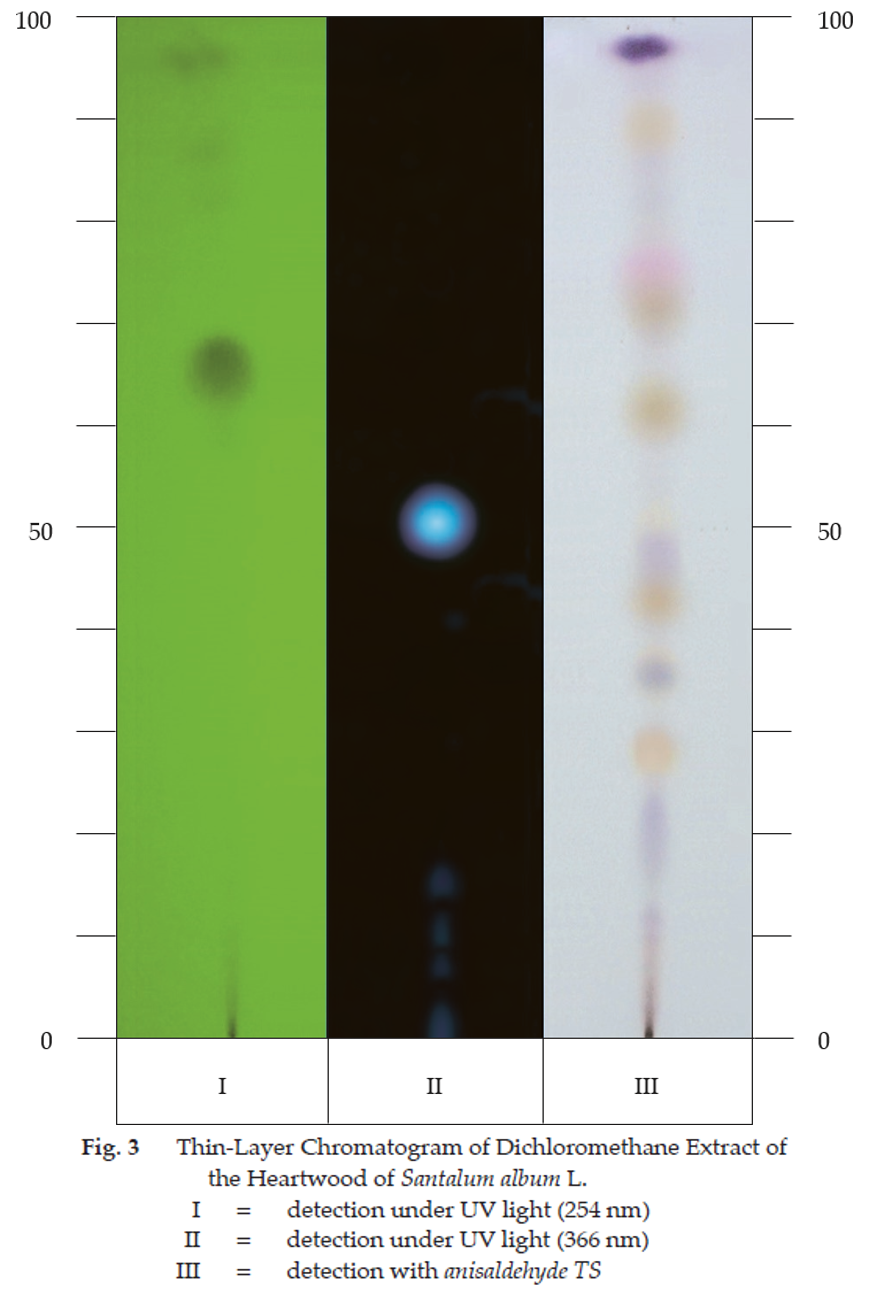ตำรามาตรฐานยาสมุนไพรไทย
Thai Herbal Pharmacopoeia
สำนักยาและวัตถุเสพติด กรมวิทยาศาสตร์การแพทย์ กระทรวงสาธารณสุข
Bureau of Drug and Narcotic, Department of Medical Sciences, Ministry of Public Health(Tinospora crispa (L.) Hook.f. & Thomson)
(Nelumbo nucifera Gaertn.)
(Centella asiatica (L.) Urb.)
(Centella Dry Extract)
(Centella Cream)
(Mesua ferrea L.)
(Piper sarmentosum Roxb.)
(Piper sarmentosum Roxb.)
(Pterocarpus santalinus L. f.)
(Santalum album L.)
(Senna tora (L.) Roxb.)
(Senna alata (L.) Roxb.)
(Senna Alata Tea)
(Piper retrofractum Vahl)
(Myristica fragrans Houtt)
(Andrographis paniculata (Burm. f.) Nees)
(Andrographis Capsules)
(Allium ascalonicum L.)
(Ocimum tenuiflorum L.)
(Curcuma longa L.)
(Turmeric Capsules)
(Turmeric Dry Extract)
(Turmeric Dry Extract Capsules)
(Arcangelisia flava (L.) Merr.)
(Curcuma sp.)
Harrisonia perforata (Blanco) Merr.
(Aristolochia pierrei Lecomte)
(Zingiber officinale Roscoe)
(Ginger Capsules)
(Ginger Tea)
(Cassia fistula L.)
(Nardostachys jatamansi (D. Don) DC.)
(Angelica sinensis (Oliv.) Diels)
Artemisia annua L.
(Ligusticum sinense Oliv. cv. Chuanxiong)
(Neopicrorhiza scrophulariiflora Pennell)
(Atractylodes lancea (Thunb.) DC.)
(Aucklandia lappa Decne)
(Terminalia chebula Retz.)
(Angelica dahurica (Hoffm.) Benth. & Hook. f. ex Franch. & Sav. var. dahurica)
(Kaempferia parviflora Wall. ex Baker)
(Hibiscus sabdariffa L.)
(Roselle Tea)
(Allium sativum L.)
(Zingiber zerumbet (L.) Sm.)
(Wurfbainia testacea (Ridl.) Škorničk.& A. D. Poulsen)
(Cannabis sativa L.)
(Myristica fragrans Houtt)
(Dracaena cochinchinensis (Lour.) S. C. Chen)
(Ficus racemosa L.)
(Hyptis suaveolens (L.) Poit.)
Clerodendrum indicum (L.) Kuntze
(Phyllanthus emblica L.)
(Citrus hystrix DC.)
(Citrus hystrix DC.)
(Areca catechu L.)
(Momordica charantia L.)
Moringa oleifera Lam.
(Aegle marmelos (L.) Corrêa)
(Solanum trilobatum L.)
(Morus alba L.)
Gynostemma pentaphyllum(Thunb.)
Makino
(Clinacanthus nutans (Burm. f.) Lindau)
(Cissus quadrangularis L.)
(Mimusops elengi L.)
(Zingiber montanum (J. König) Link. ex A. Dietr.)
(Piper betle L.)
(Capsicum annuum L.)
(Capsicum Oleoresin)
(Capsicum Gel)
(Piper nigrum L.)
(Piper nigrum L.)
(Eurycoma longifolia Jack)
(Thunbergia laurifolia Lindl.)
(Piper wallichii (Miq.) Hand.-Mazz.)
Senna garrettiana (Craib) H. S. Irwin & Barneby
(Terminalia bellirica (Gaertn.) Roxb.)
(Terminalia chebula Retz.)
(Caesalpinia bonduc (L.) H. Roxb.)
(Tarlmounia elliptica (DC.) H. Rob., S. C. Keeley, Skvaria & R. Chan)
(Hog Creeper Vine Dry Extract Capsiles)
(Hog Creeper Vine Dry Extract)
(Brachypterum scandens (Roxb.) Miq.)
(Lepidium sativum L.)
(Nigella sativa L.)
(Cuminum cyminum L.)
(Foeniculum vulgare Mill.)
(Plantago ovata Forssk.)
(Pimpinella anisum L.)
(Carum carvi L.)
(Anethum graveolens L.)
(Trachyspermum ammi (L.) Sprague)
Albizia procera (Roxb.) Benth.
(Acorus calamus L.)
(Tiliacora triandra (Colebr.) Diels)
Cyanthillium cinereum (L.) H. Rob.
(Orthosiphon aristatus (Blume) Miq.)
Murdannia loriformis (Hassk.) R. S. Rao & Kammathy
(Capparis micracantha DC.)
(Chrysopogon zizanioides (L.) Roberty)
(Cyperus rotundus L.)
(Cannabis sativa L.)
(Syzygium aromaticum (L.) Merr. & L. M. Perry)
(Boesenbergia rotunda (L.) Mansf.)
(Acanthus ebracteatus Vahl)
(Acanthus ilicifolius L.)
(Kaempferia galanga L.)
(Curcuma comosa Roxb.)
Betula alnoides Buch.-Ham. ex D. Don
Cannabis sativa L.
Carthamus tinctorius L
Mitragyna speciosa (Korth.) Havil
Mallotus repandus (Rottler) Müll. Arg
Azadirachta indica A. Juss. var. siamensis Valeton
Azadirachta indica A. Juss. var. siamensis Valeton
Punica granatum L.
Rhinacanthus nasutus (L.) Kurz
Baliospermum solanifolium (Burm.) Suresh
Curcuma aeruginosa Roxb
Boesenbergia kingii Mood & L. M. Prince
Senegalia rugata (Lam.) Britton & Rose
Acacia concinna (Willd.) DC.
Senegalia rugata (Lam.) Britton & Rose
Acacia concinna (Willd.) DC.
Senna alexandriana Mill. var. alexandriana
Cassia acutifolia Delile, Cassia angustifolia Vahl
Butea superba Roxb. ex Willd.
[Plaso superba (Roxb. ex Willd.) Kuntze, Rudolphia superba (Roxb. ex Willd.) Poir.
Pueraria candollei Graham
ex Benth. var. mirifica (Airy Shaw & Suvat.) Niyomdham
Streblus asper Lour.
Suregada multiflora (A. Juss.) Baill. (Gelonium
multiflorum A. Juss.
Sandalwood is the dried heartwood of Santalum album L. (S. album Rumph., S. ovata R. Br., S. ovatum Miq., S. myrtifolium L., Sirium myrtifolium L.) (Family Santalaceae), Herbarium Specimen Number: DMSC 5178, BKF 168153, Crude Drug Number: DMSc 0935.
Constituents Sandalwood contains volatile oil, of which α- and β-santalol are major components. The volatile oil also contains santenone, santalone, α-terpineol, etc.
Description of the plant (Figs. 1a, 1b) Hemiparasitic tree up to 20 m tall; glabrous; bark rough, cracked, dark grey or brownish black. Leaves simple, opposite or sub-opposite, elliptic-lanceolate or ovate, coriaceous, 4 to 11 cm long, 1.5 to 3.5 cm wide, apex acute or
shortly acuminate, base obtuse, attenuate, margin undulate; petiole slender, about 1 cm long. Inflorescence paniculate, terminal or axillary, pedunculate; peduncle slender, tortuous. Flowers 9 to 15, receptacular, pedicellate; pedicel slender, angular, 1 to 3 mm long; perianth tube campanulate, 4- to 5-lobed, deltoid, 1.5 to 3.5 mm long, 1 to 1.5 mm wide, reflexed, whitish, turning reddish then crimson; stamens 4 or 5, opposite to perianth lobes, filament narrow, slightly dilated at the base, covered with white hair-tuft; ovary semi-inferior, style angular, stigma 3-lobed; nectary concave, deeply 5-lobed, protruding between the perianth segments, brownish, turning reddish then crimson. Fruit drupe, globose or subglobose, about 1 cm in diameter, green, turning red then purplish black, juicy when ripe; exocarp smooth; endocarp ribbed. Seed 1, globose or obovoid.
Description Odour, aromatic, strongly aromatic when burning; taste, slightly bitter.
Macroscopical (Fig. 1a) Cylindrical woody segment, varying in size and diameter, some somewhat curved. Externally pale yellow or yellowish brown, fine and smooth, some with nodal scars or longitudinal cracks. Texture compact, uneasily broken; transversely cut surface brownish yellow, showing annual rings; longitudinally cut surface shows straight grains.
Microscopical (Figs. 2a, 2b, 2c, 2d) Transverse section of the heartwood shows vessel, xylem parenchyma, xylem ray, and fibre. Vessel, single, large, thick-walled, and scattered. Xylem parenchyma, round, thick-walled, apotracheal, and some of which contain prismatic crystals of calcium oxalate. Xylem ray, 1 to 3 rows, some of which contain red or brownish oleoresin. Fibre, thick-walled.
Tangential and radial longitudinal sections of the heartwood show vessel, xylem parenchyma, fibre, fibre-tracheid and xylem ray. Vessel, large, with bordered-pitted and simple perforation plate. Xylem parenchyma, thick-walled, some of which contain prismatic crystals of calcium oxalate. Fibre, thick-walled, simple pitted. Fibre-tracheid, thick-walled, bordered-pitted with tapering ends. Xylem ray; in tangential longitudinal view, mostly multiseriate, oval, some of which contain red or brownish oleoresin; in radial longitudinal view, rectangular, perpendicular to other adjacent cells.
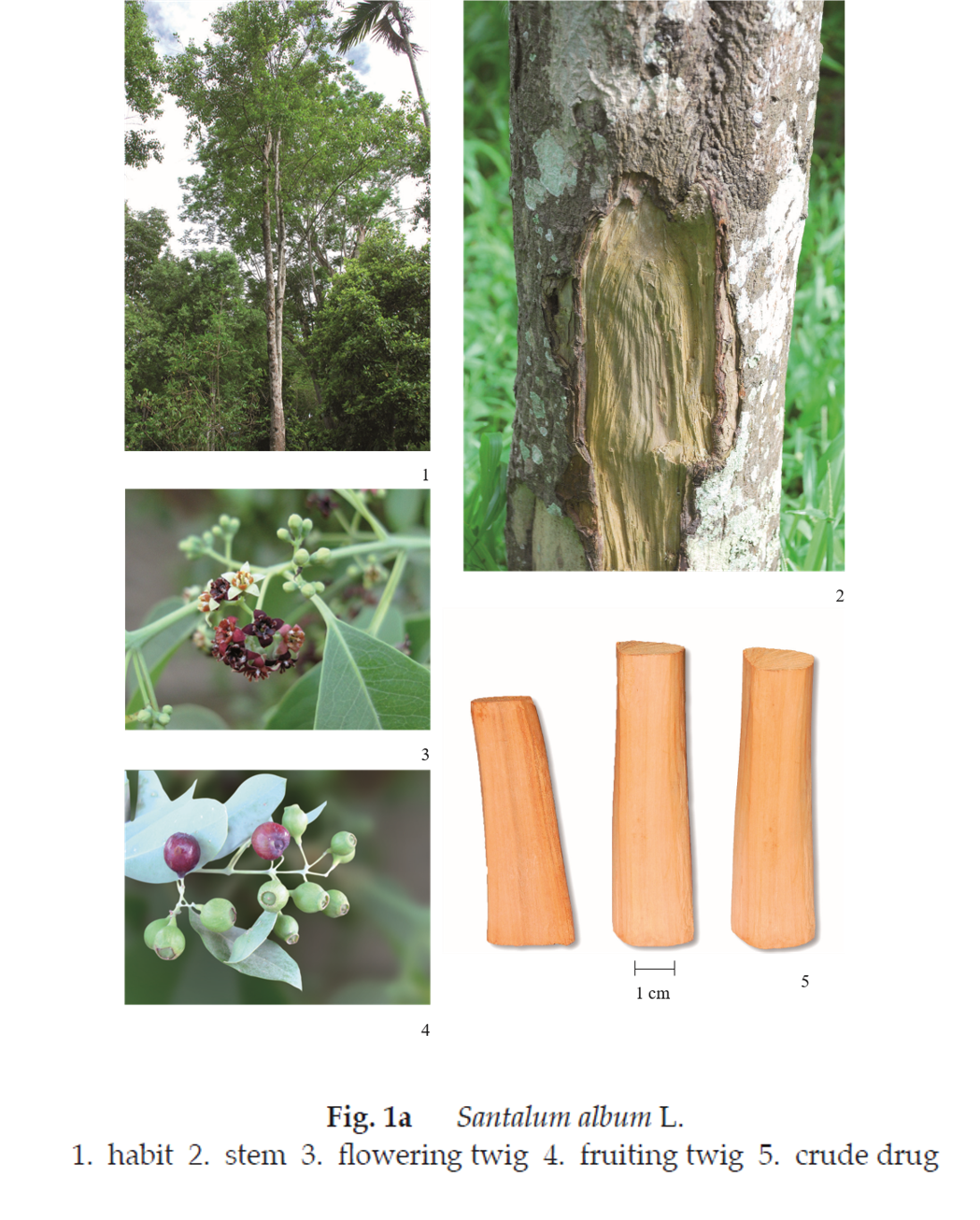
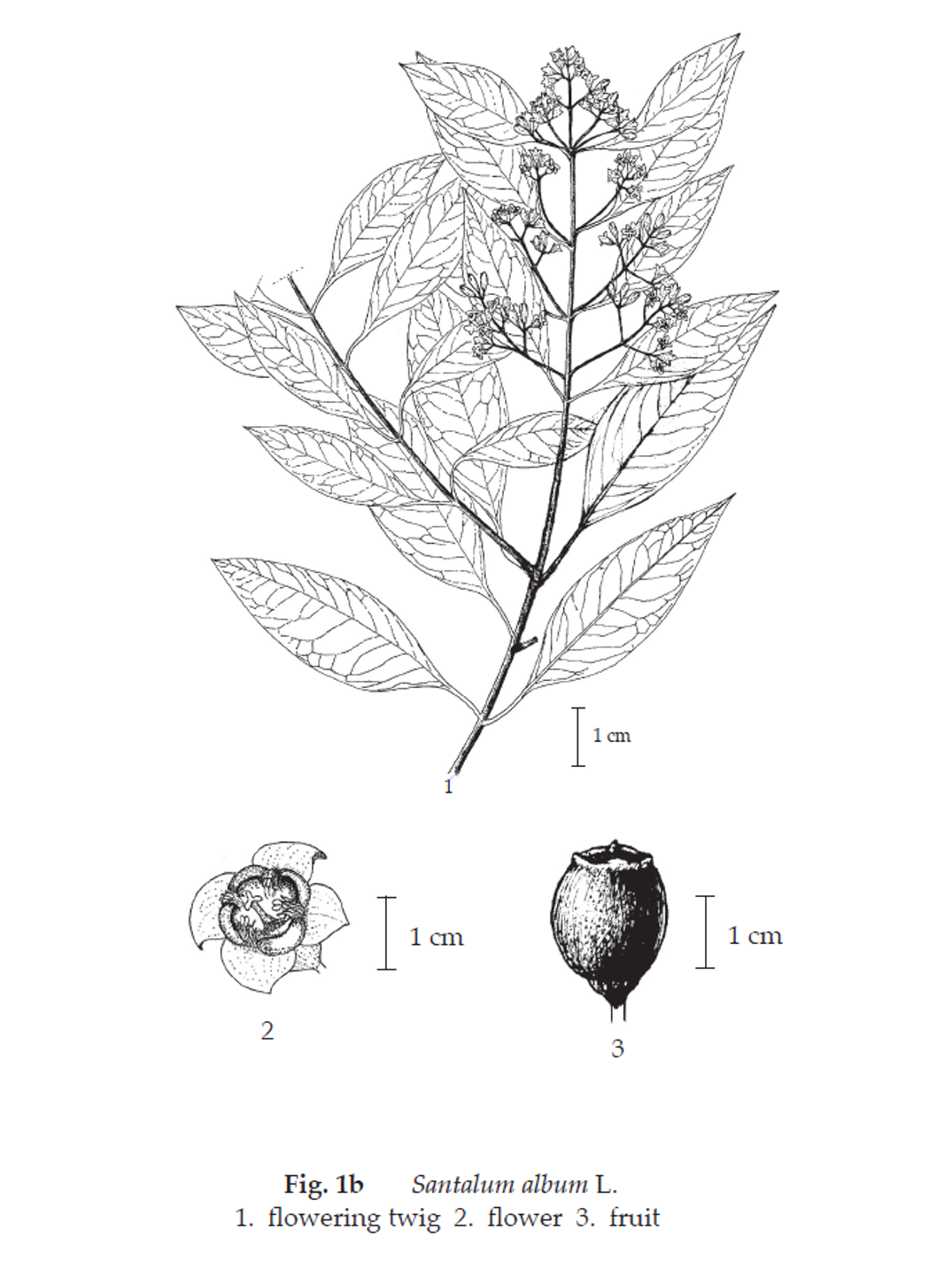
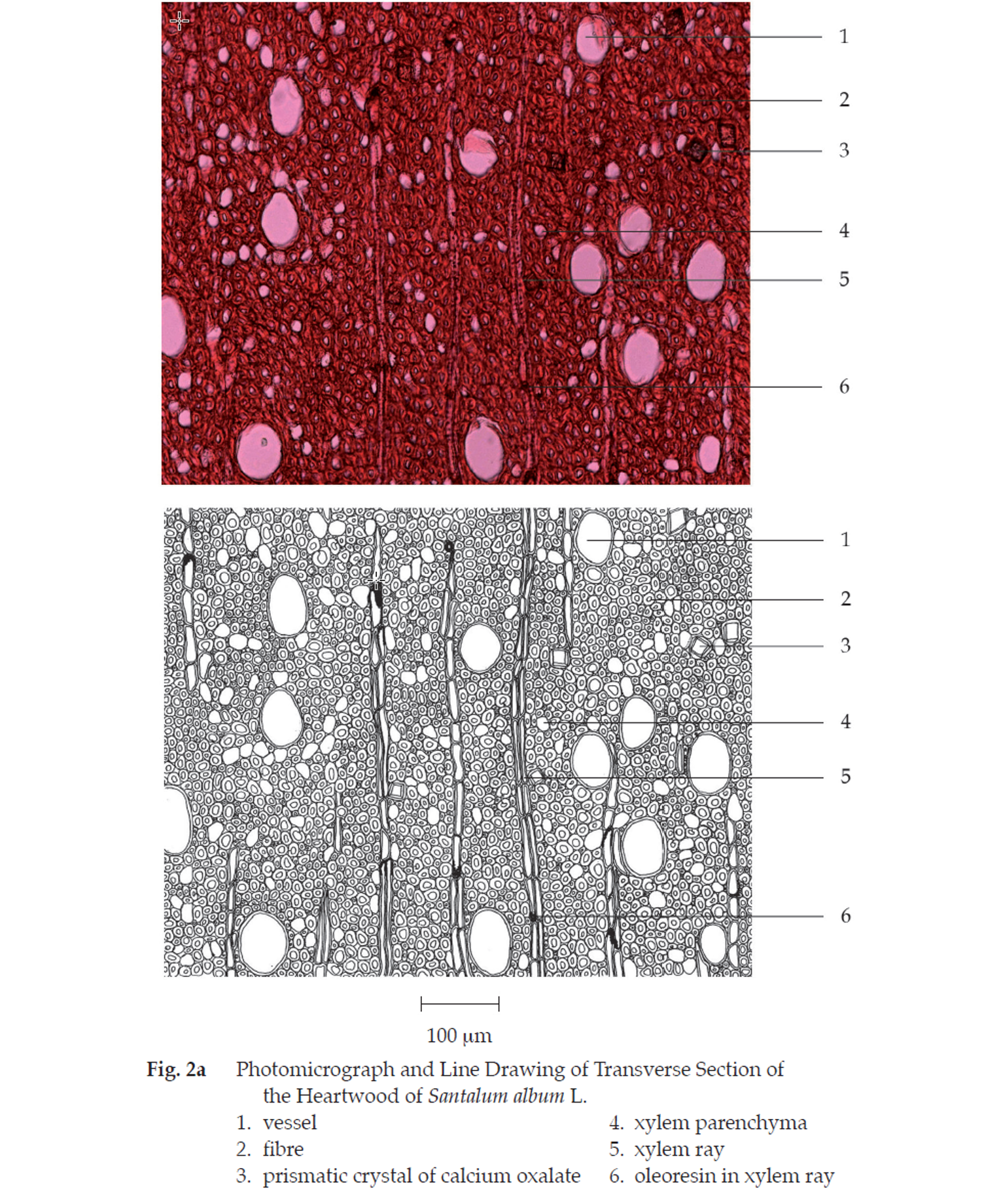
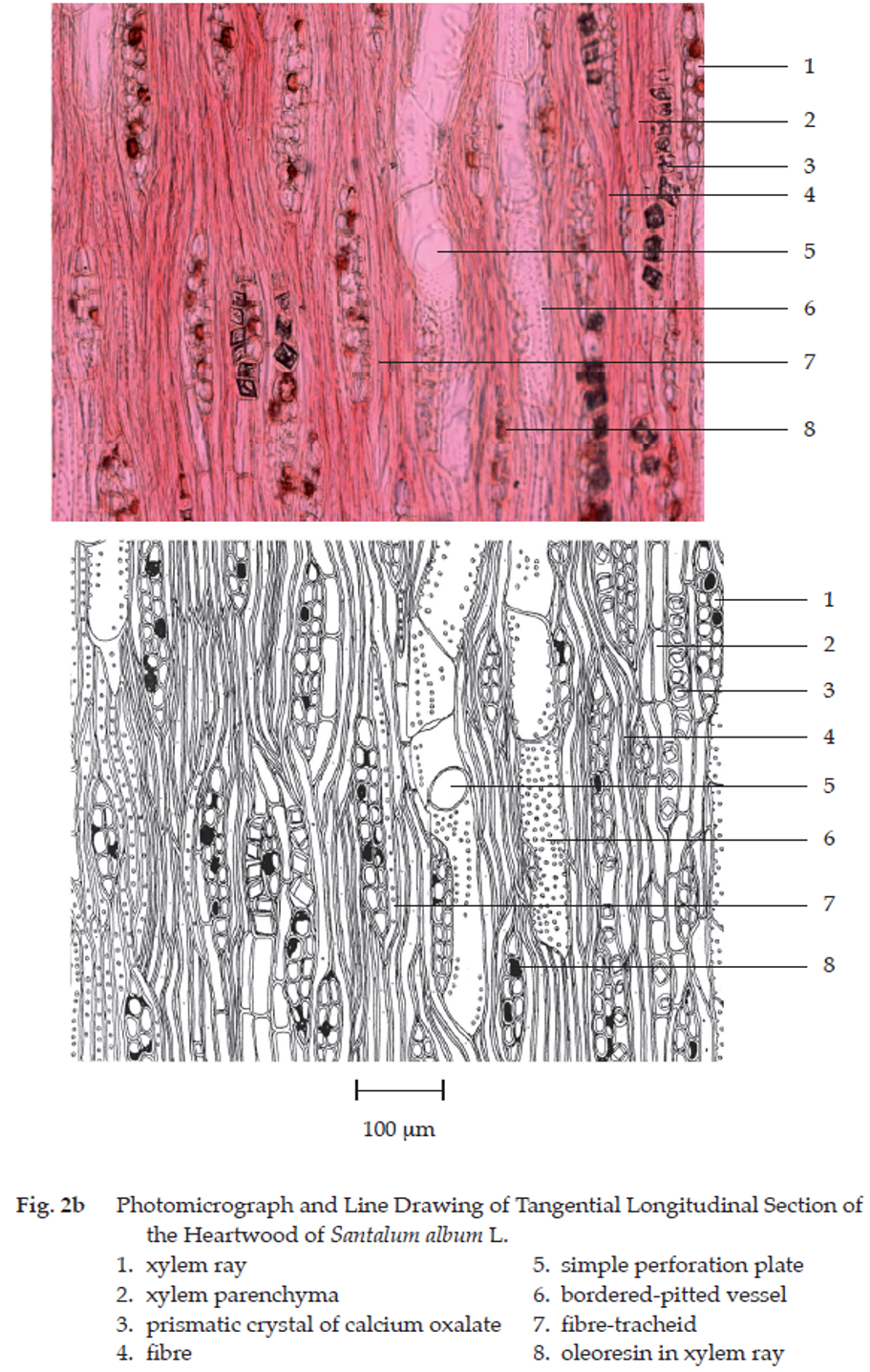
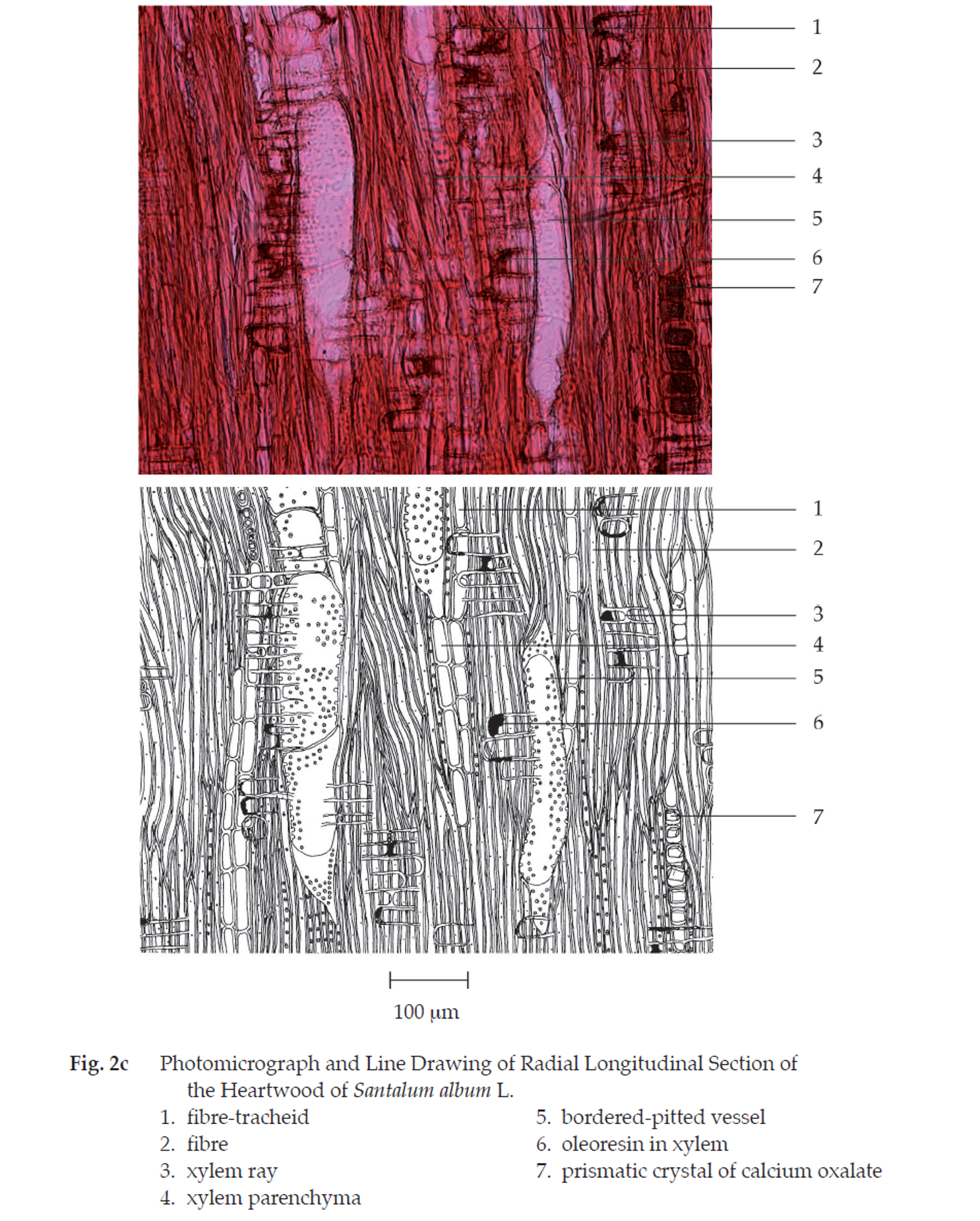
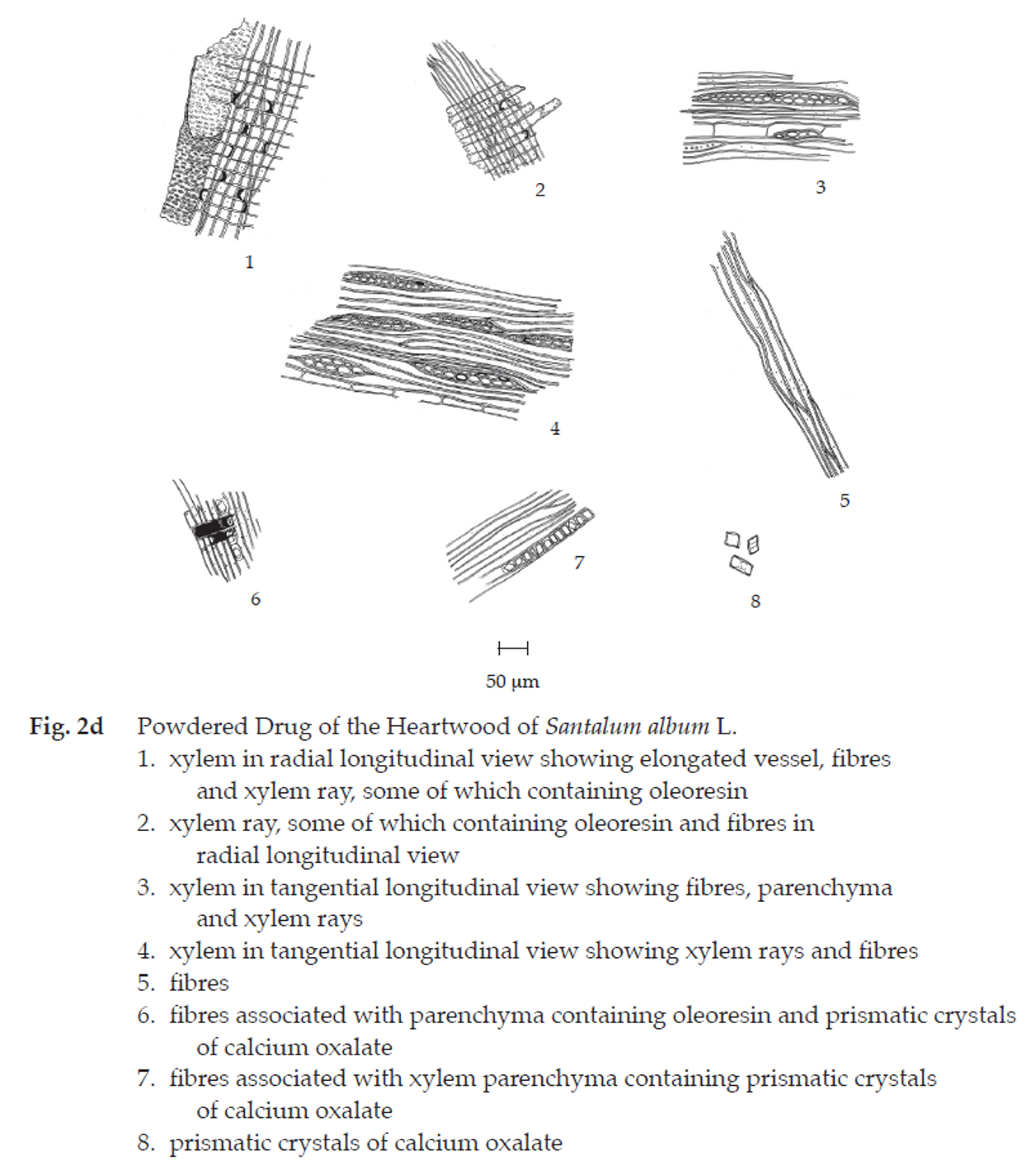
Sandalwood in powder possesses the diagnostic microscopical characters of the unground drug.
Storage Sandalwood shall be stored in a cool and dry place, protected from light.
Identification
A. Reflux 1 g of the sample, in powder, with 20 mL of methanol for 15 minutes and filter (solution 1). Evaporate 2 mL of solution 1 to dryness. Dissolve the residue in 2 mL of acetic anhydride, and then slowly add 1 mL of sulfuric acid to form two layers: a brown colour forms at the zone of contact and the upper layer is green.
B.To 2 mL of solution 1, add a few drops of iron(III) chloride TS: a green colour is produced.
C. Carry out the test as described in the “Thin-Layer Chromatography” (Appendix 3.1), using silica gel GF254 as the coating substance and a mixture of 90 volumes of toluene and 10 volumes of ethyl acetate as the mobile phase. Apply to the plate, 5 µL of the test solution prepared by refluxing 1 g of sample, in powder, with 30 mL of dichloromethane for 30 minutes and filtering. Evaporate the filtrate to dryness and dissolve the residue in 1 mL of toluene. After removal of the plate, allow it to dry in air and examine under ultraviolet light (254 nm), marking the quenching spots. Subsequently examine the plate under ultraviolet light (366 nm) through the cut-off filter; one intense blue fluorescent spot is observed. Spray the plate with anisaldehyde TS and heat at 110° for 10 minutes; several spots of different colours appear (Table 1); see also Fig. 3.
| Spot | hRf Value | Detection | ||
| UV 254 | UV 366 | Anisaldehyde TS | ||
| 1 | 15-22 | - | - | violet |
| 2 | 25-30 | - | - | orange |
| 3 | 32-38 | - | - | violet |
| 4 | 40-45 | - | - | brown |
| 5 | 45-48 | - | - | pale violet |
| 6 | 50-52 | - | intense blue | - |
| 7 | 58-64 | - | - | brown |
| 8 | 65-68 | quenching | - | - |
| 9 | 69-73 | - | - | brown |
| 10 | 73-76 | - | - | pink |
| 11 | 85-88 | - | - | pale brown |
| 12 | 94-97 | weak quenching | - | violet |
Water Not more than 9.0 per cent v/w (Azeotropic Distillation Method, Appendix 4.12).
Foreign matter Not more than 0.5 per cent w/w (Appendix 7.2).
Total ash Not more than 1.5 per cent w/w (Appendix 7.7).
Ethanol-soluble extractive Not less than 3.0 per cent w/w (Appendix 7.12).
Water-soluble extractive Not less than 3.0 per cent w/w (Appendix 7.12).
Volatile oil Not less than 1.0 per cent v/w (Appendix 7.3H). Use 30 g, in coarse powder, freshly prepared and accurately weighed. Use 300 mL of water as the distillation liquid and a 500-mL round-bottomed flask. Distil at a rate of 2 to 3 mL per minute for 5 hours. Use 2.0 mL of xylene in the graduated tube.
Dose 2 to 6 g a day.
